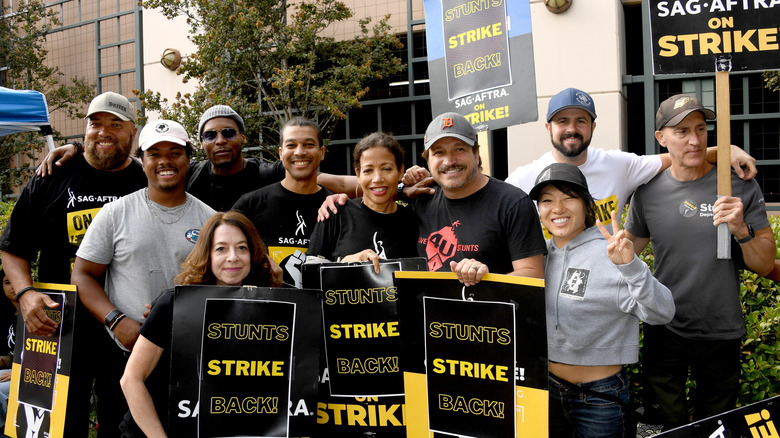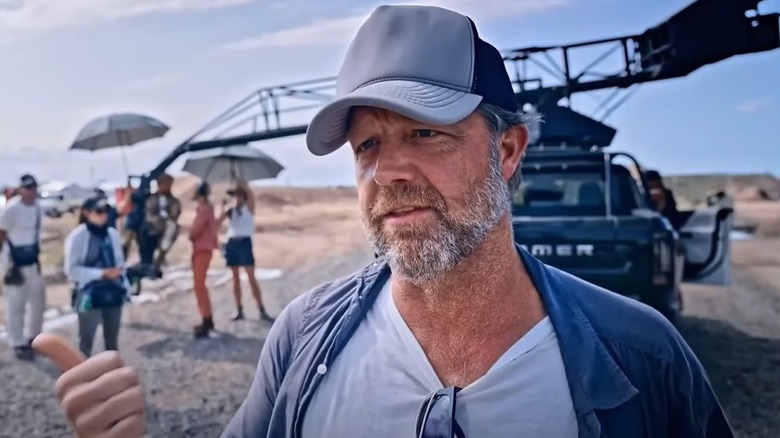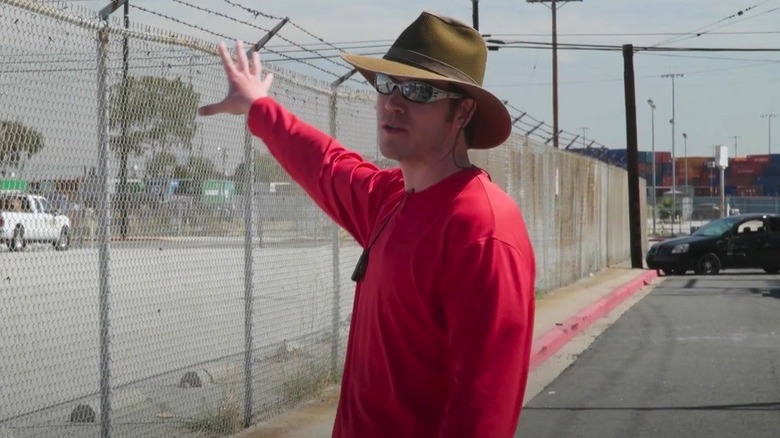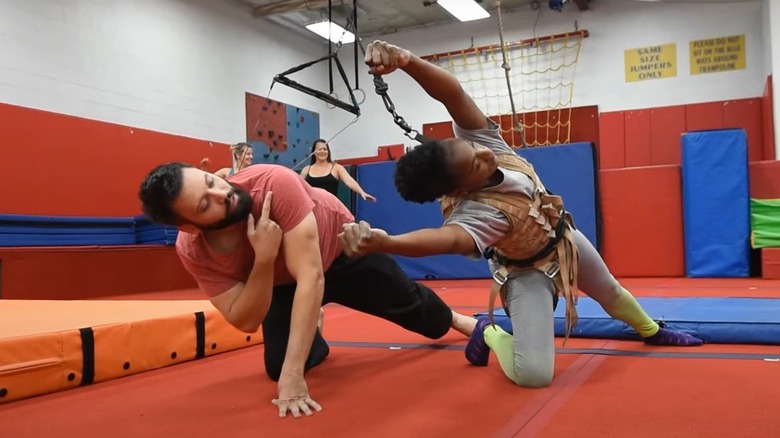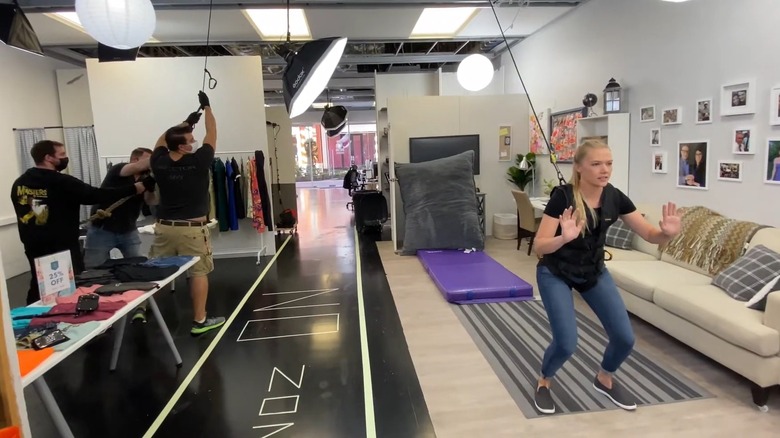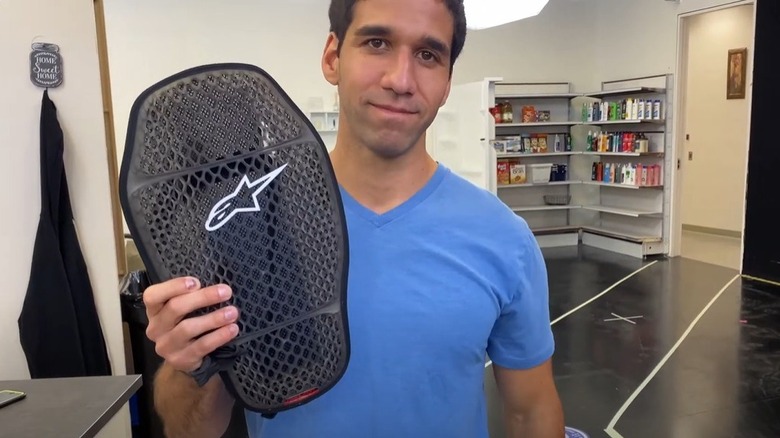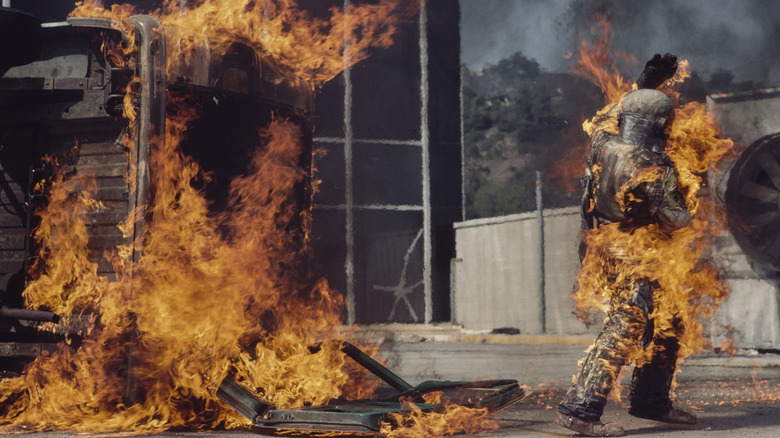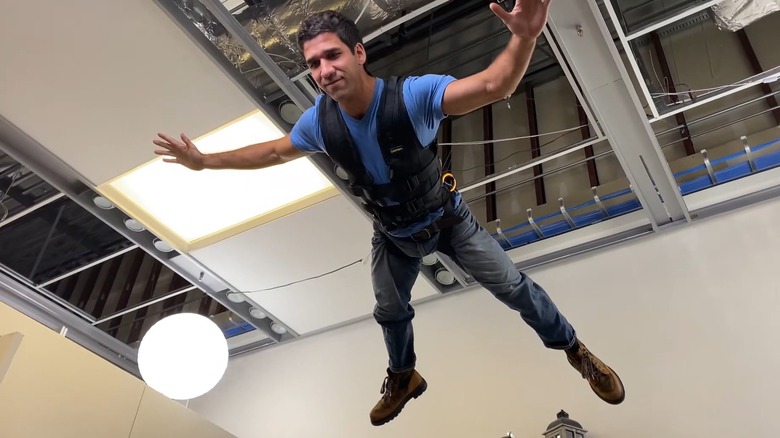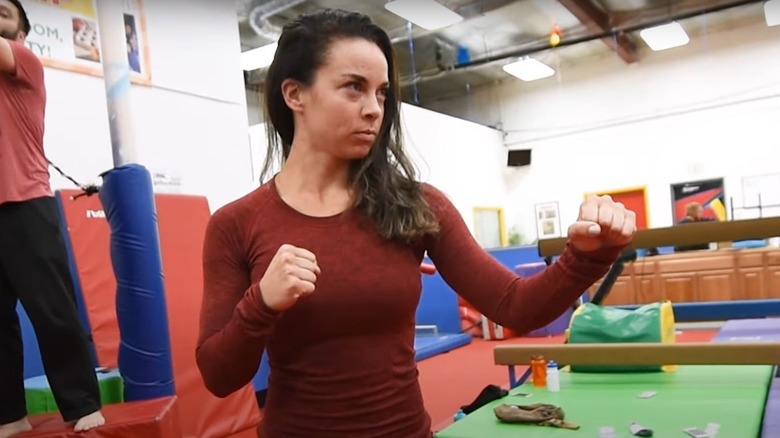Strict Rules Stunt Performers Have To Follow On Set
It takes a lot of guts to hurl yourself out of a tenth-story window, even if you're covered in padding and there's a net to break your fall. Or to set yourself ablaze, even if you're covered in a flame-deterring gel and have several firefighters waiting nearby with extinguishers, prepared to put you out if things go wrong. Or to drive a car at top speed through a busy mall and crash right through a glass window to freedom.
Stunt performers have to do things like this all the time to earn a paycheck. Many of the most unbelievable stunts you see in movies are totally real, and while some actors do their own stunts, most of the time it's left to the professional doubles. In spite of the constant danger they face, stunt performers have only just begun to get accolades and professional recognition for their work: The Academy Awards will finally recognize stunt design as a valid and laudatory occupation during its 2027 ceremony.
Many in the stunt game have started to get better benefits, too, having joined hands with SAG-AFTRA and participated in the 2023 strikes in search of equal pay (stunt coordinators were the major beneficiaries of this, winning fixed residuals for shows and films on streaming platforms). But even with a renewed spotlight shining on them, stunt performers must obey a set of rules to stay safe on set. Here are the things every stunt person has to agree to do in order to perform in a Hollywood production.
Stunt performers must adhere to SAG-AFTRA rules
After the 2023 Hollywood strikes ended in a deal, a list of common standards and practices for stunt people was uploaded to the SAG-AFTRA website. It declares that they must abide by union rulings: Anything the actor's union has agreed to is something a stunt performer has to abide by as well while on-set working. If they catch anyone violating these rules, they are strongly encouraged to report them to the union. The website states: "If the violation is determined to be founded, in lieu of any recourse to proceedings under Article XIV of the Constitution, the staff, in consultation with committee leadership, as appropriate, will reach out to that stunt coordinator to educate him or her on the standards and practices, and will assist the stunt coordinator in determining how to proceed with respect to the particular issue in question."
Stunt performers went all-in with their support during the strikes. Mike Massa, who has performed stunts for Harrison Ford, even set himself on fire during one rally, with the footage going viral. While they did receive a pay raise and some royalty benefits related to work for streamers (Netflix's original movies contain several amazing stunts you need to watch at least once), not everyone was happy. Some performers noted that the deal fails to protect against AI replication of their images, allowing studios to potentially clone thousands of digital stunt people instead of hiring flesh and blood workers. "I'm terrified [this contract] is going to decimate the stunt industry. The stunt community — [which] is really small — is really getting screwed over. We don't have the numbers to stop this from going through. We just don't," Heidi Pascoe, a member of the Stuntwomen's Association of Motion Pictures, told the New York Post.
Everyone has to be on the same page
Whether they agree with everything SAG-AFTRA does or not, members of stunt unions like The Stuntmen's Association of Motion Pictures and The Stuntwomen's Association of Motion Pictures all agree on one thing — the most important thing anyone coordinating or participating in stunt work can do is obey every single safety rule. The goal is no injuries with as little unintended property damage as possible. Since stunt work is all about doing seemingly impossible things with the human body and coming out the other side in one piece, everyone has to be on the same page, and everyone needs to know exactly what will be happening in each shot.
When movie stars do their own stunts, such as Tom Cruise's many dangerous stunts for the "Mission: Impossible" series, things can get even more hairy. Insurance issues can crop up, and directors can risk hurting or permanently disabling their stars for the sake of authenticity. Even the actors need to obey the union safety laws, famous or not. Of course, it helps when the director has knowledge of the stunt industry, and few are more tuned-in to that world than David Leitch.
Leitch spent years in front of the camera as a stunt professional doubling for the likes of Brad Pitt and has the scars to prove it. He admits that now that he's the one directing the shots, the weight of responsibility is heavily on his shoulders. "It's harder because you have your friends that are doing the stunts and you're designing them and you are responsible for their safety. Your heart goes through your chest," he told NPR. His film "The Fall Guy" is so indebted to the stunt world that it ends with a credits-long tribute to the men and women who performed stunts in the film.
They have to attend safety meetings
It probably won't surprise you to learn that stunt people are required to attend safety meetings, usually headed by the stunt coordinator with the first assistant director present. During these gatherings, the crew and the safety team huddle up and go over the procedures and regulations so that everyone who's involved with putting together each stunt is on the same page and knows exactly what their job is. They will also be told where to turn if there's an emergency. Things can become complicated if, in spite of all the meetings, things go awry, like they did with the controversial "Rust" shooting that saw Alec Baldwin charged with two counts of involuntary manslaughter (the trial was dismissed after it was discovered that certain evidence had been withheld from the defense).
The Occupational Safety and Health Administration might get involved, like they did in the case of "Midnight Rider" — director Randall Miller and several other people involved with the production were charged with involuntary manslaughter and criminal trespass after assistant camerawoman Sarah Jones was struck and killed by a train during the shoot, which led to Miller serving jail time. Of course, it's far more common for a stunt performer to lose their life on set — sadly, many movie scenes have actually killed stunt actors. Stunt people have died on everything from the '80s Tom Cruise classic "Top Gun" and the Brad Pitt epic "Troy" to the superhero blockbuster "Deadpool 2." Sometimes, no matter how talented and dedicated a stunt person is, accidents happen.
They have to work under a stunt coordinator
It's a SAG-AFTRA rule that all productions which include stunt work must hire a coordinator to keep things safe and organize all stunt personnel as well as the stunts themselves. "When a producer requires script or non-script stunts or stunt-related activity of a performer, an individual qualified by training and/or experience in the planning, setting up and/or performance of the type of stunt involved shall be engaged and present on the set," the union website states.
The stunt coordinator is also tasked with staying in contact with all attendant branches of the production involved in any stunt-related matter, like the wardrobe department and props. That can mean wrangling dozens of people, consulting with storyboards, trying to keep up with the continuity department, and being sure that the relevant authorities are present on set when needed. It can be a monumental task to harmonize so many branches of a production, but most stunt co-ords know how to take the heat — sometimes literally — to get the job done on time.
For stunt coordinators, what they do is an art form. Industry vet James O'Donnell, who put together action scenes for the Oscar-nominated "Belfast," explained to Variety: "I'm listed as a stunt coordinator but what I am is an action designer. My job is to interpret the script and the spirit of what the director wants, whether it's a big action movie where we're blowing stuff up or on a movie like this."
Preparation is paramount
What's the most important thing about being a stunt person? Remaining clear-eyed, sharp-minded, and focused. Whether one has to jump out of an airplane, lead a battle against a raging torrent of enemy soldiers, or be mock-crushed by a falling tree, if you don't have your wits about you it's very easy to get hurt or accidentally injure others. Coming to the set tired, ill, or impaired in any way can have devastating consequences. This is why many stunt performers attend stunt training academies before becoming Hollywood professionals.
For many stunt workers, it's all about balancing the mind and the body. The art of creating a stunt takes careful planning, not maverick-like impulsive behavior. They may do seemingly crazy things on set, but every inch of a stunt is mapped out to the tiniest detail. "Good stunt work is all about preparation and breaking down the stunt into simple steps," Logan Holladay, who has done stunts for films like "The Fall Guy," told Men's Health. "I know what marks I need to hit and focus on each step. I'm not a daredevil — nothing could be farther from the truth: the stunt I do are very calculated."
Protective gear is a must
This might be a no-brainer of a rule, but all performers who do stunts that require them to take a blow, fall from some height, or deal with any sort of impact are required to wear protective gear — helmets, padding, gloves, and anything that can properly protect them. Many performers maintain a Personal Protective Equipment or PPE bag — for some, simply a stunt bag — filled with all of the equipment they need to use to keep them safe, which they bring with them every time they go to a movie or television shoot.
The typical PPE bag tends to include items like helmets which protect the mouth and face and are specifically designed to keep stunt performers from biting their tongues or cracking their teeth; wrist and elbow pads; knee pads; a back protector and padded shorts and vests. Naturally, the kind of PPE that a stunt person brings to a shoot can vary depending on the stunt they have agreed to perform, but they'll always have something on hand to make their job less painful.
Real firefighters must be present for fire stunts
Whenever something's set aflame on set, plenty of preparation is required. A special effects person — usually a pyrotechnic who specializes in fire-related scenes — needs to be there, and real firemen who have certification as motion picture and television safety officers need to be present, in addition to a stunt coordinator. Los Angeles has a special training program that helps firefighters get extra certifications so they can work on films. "We're really trying to educate the local fire service as far as the movie industry way of doing things that are out of the norm," Cindy Moore, former deputy state fire marshal, told the Los Angeles Times. "We want to make them feel comfortable with things they are not going to see every day, so when something is going sideways, they can make it a safe environment."
It's worth noting that, once upon a time, the fire department and stunt coordinators didn't always work in harmony. In fact, many in the stunt community prefered not to involve them. "When I first got into this business, I was brought up to avoid the fire marshal — they were the bad guys," stunt coordinator Joe Ordaz told the Los Angeles Times. "Today, firemen and stuntmen – we're the best of friends. From my perspective, the more eyes we have on the set the better so we're all on the same page." Needless to say, closer relations between the stunt and firefighting community is a good thing for Hollywood, particularly the performers who are willing to be engulfed in flames for the sake of our entertainment.
Rigging must be used for fall stunts
If you're going to have a character take a huge tumble, rigging is an extremely important part of the stunt crafting process. It's a requirement on sets that if someone's going to fall during a scene, all proper precautions must be taken, which means harnessing and wiring actors and stunt people to be sure that their fall doesn't result in death or injury. Stunt wire riggers in particular must be employed to properly sail the actors across a soundstage, and they must be sure that the harnesses are calibrated for the stunt performer's weights.
Naturally, when one works in wire rigging, being in a very high place and in very rough elements are a big part of the game. How do riggers prepare? With a lot of energy-draining activities that get you out among the elements. This is according to Keir Beck, who used to be a tree surgeon. "Being an arborist in my former life I still climb trees as much as I can," Beck told Men's Health. "I also strength train, swim, trail run, sea kayak and mountain bike. I call this my adversity training, following in the footsteps of Marcus Aurelius. So, if it's hot, cold, raining, windy or rough seas I am into it. This type of training allows me to work 10-14 hour days in any conditions and not be fazed."
Never ignore the fight coordinator
If fists are going to be thrown on screen, then a fight coordinator needs to be employed to safeguard the actors in question. They choreograph actors and stunt people to ensure the conflict is pre-planned, yet looks natural. Sometimes stunt performers undertake the more difficult parts of a fight, and sometimes actors insist upon being the ones delivering those pulled punches. Choreographing a fight scene usually involves planning with previs (preparatory visual planning techniques like storyboards, animatics, or computer models) and rehearsals with the performers, cameras or stand-ins, so that everyone is where they need to be. It helps to have a fight coordinator who has also worked as a stunt performer in the past, which is the case with Hiro Koda.
"It's a pretty dangerous job so I always quadruple check to make sure everything's as safe as possible," Koda told The Motion Picture Association's The Credits. "I have 30 years of experience so I know the best way to do the stunt and how it's going to feel." Koda, who won an Emmy for his stunt coordination work on "Stranger Things," is among those who believe that previs is vitally important. "I like to shoot live-action previs during prep so I'll bring in my stunt doubles, rehearse the action, and film it. If we don't have access to the actual set I build something similar." So, if you're a stunt performer who is going to be involved in a fight scene, the golden rule is that you always follow the steps laid out by the fight coordinator, unless you want to end up with (or end up giving someone) a black eye.
They have to stay in peak physical condition
Unsurprisingly, to be a stunt performer one has to be physically fit. Strength, speed, and endurance are all major qualities they need to embody. Many organizations dedicated to supporting stunt performers note the importance of being properly conditioned for the business, and that's not just in Hollywood. "To excel in stunts, you need to maintain peak physical condition," notes the not-for-profit association Australian Stunts Organisation. "This involves regular cardiovascular exercises to boost endurance, strength training to build the necessary muscle power, and flexibility routines to increase your range of motion." As such, stunt performers have to adhere to strict workout routines. When actors get ripped for a role it tends to get a lot of attention, but that also means the people doubling for them have to be equally jacked. So how do they do it?
Stunt person workouts differ from pro to pro. Kortel Autrey, who specializes in motorcycle stunts, does "a lot of core work," he told Men's Health. "My go-to daily routine is a 12-minute session called Foundation Training — a series of bodyweight exercises that fire up your glutes, core, and stretches out your back." Troy Brown, who is mainly employed to take falls, takes a different approach. "I need to stay limber, so I stretch every day for 15 minutes, then do strength and trampoline work five days a week, and motocross for cardio on weekends," he revealed to the mag. "On the trampoline I practice getting my body in weird positions in midair and finding a way to land on my back. You learn how to twist and rotate faster and slower." It really depends on your particular discipline, but they all follow one golden rule — never skip the gym.

